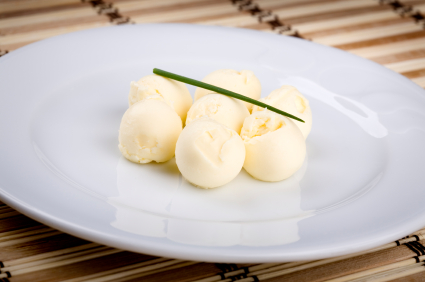Good Fat: How Much Is Too Much?

I was busy working away on my top-secret Woman Incredible Platinum Mentoring program* and almost didn’t notice that I scarfed down an entire 100 grams of grass-fed beef (grilled), some free-range bacon, 2 (okay more like 3) scrambled eggs, and a nice little pile of spinach sauteed with butter. Yummy-yum-yum.
I’d have a photo for you but I ate it so fast not only is that not possible, but my insulin levels are currently no-doubt skyrocketing through the ceiling. The fact that I’m currently working my way through my second coffee with extra extra cream and a little chocolate on the side probably isn’t too helpful. Although I did walk for 15 minutes after the meal to get to the coffee.
Anyway. Enough blathering on.
when it comes to good fat, how much is too much?
One of the things I get asked time and again by my fat loss clients is what sort of food quantities to go for. And you know what? When it comes to (lean) protein, greens and most foods in their natural state I’m not usually super-picky about amounts. At least to start with 😉
But when it comes to even good fat?
Too much is definitely too much. I’ve seen more than one motivated lady completely halt her progress by getting just a little bit too excited about now having ‘permission’ to indulge in richer and yes even creamer foods. Myself included, in case you can’t tell from the above example 🙂
basic rules to follow when eating good fat
Fats plus carbs. Try not to let them collide too often. I’m talking about starch. When you eat food that is converted to sugar, and you combine that with fat, you don’t leave your metabolism much choice. The brakes go on and you may well go into fat storing mode, especially if you haven’t been very active. As a rule of thumb, a higher carb meal means lower the fat.
Quantities. Assuming you are deciding to choose a low-starch and high-protein diet most of the time, you should certainly add to it some good fats at each meal. If you avoid fats altogether you don’t give your body the building blocks of hormones, muscle, healthy hair skin and nails, and even metabolism.
So how much should you have?
If I were you I’d start relatively low, and track your energy and measurement changes over about 2 weeks. By low I’m talking 1-2 teaspoons (flat) per meal, including what you might cook in.
To increase or not to increase. Assuming your food choices continue to be 90% or so clean and sugar free, and you’re feeling satisfied, energised and your clothes are becoming looser, you can start experimenting.
One of the worst things is to get scared of eating more fat (or more anything really, as often to lose fat people do need to eat more). That being said you don’t want to get too carried away, which if you enjoy your food like I do can be very easy to do!
In my experience not many people seem to need over about 4-5 teaspoons worth of fat per meal (based on 4-6 meals p/day), and that is probably the high-end. When you experiment with more fat, keep in mind that you may need to reduce other foods accordingly. It’s all about trial and error. I would increase by an average of 10-15 grams per day and test (measurements and the way you feel) for at least a week before going further.
Timing. Keep in mind that you don’t have to space out your fats evenly. As I mentioned, I just had a really high-fat meal, coupled with some high-fat coffees. I plan to keep the rest of the day very low-fat, based around lean protein and greens. You don’t have to be anal about each meal being the same.
Quality. Fats absolutely must be organic. No ifs, buts or maybes. Fat stores toxins, which means that if you consume poor quality fat you consume toxins. Which gets stored in your fat cells. Which makes them, well, fatter. And that is really that; you can’t get around it.
Biodynamic or organic is your first choice, and in my opinion, your only. As one of my clients put it yesterday, ‘eating organic is not eating differently or making things difficult, it’s eating as nature intended. Eating conventional is what really makes things ‘difficult’, if you want to talk about the price you’ll pay.
the best good fats for fat loss
The best fats are any that are completely natural, and organic. That being said, here are a list of my favourite fats for cooking or just for adding flavour and satisfaction to your meals:
- Coconut cream
- Coconut milk
- Ghee
- Butter (raw ideally)
- Raw cream
- Not really raw milk, except a dash. Milk is sugar with some fat, cream is just fat. So much better.
- Avocado
- Macadamia nut oil
- Extra virgin olive oil
- Raw unprocessed cacao powder (low in fat but still a great addition)
- Avocado oil
- Any nuts or seeds except for peanuts (which are a legume) – this antioxidant mix is one of my regular ‘back-up’ snacks at work!
a fat-burning ‘good’ fat recipe for you to try!
Want to test out just how great you feel after a meal chock-full of good fats? This Prawn and Laksa recipe from Body Incredible is a personal favourite of mine, and it is fairly high in good fats. It’s the perfect recipe to try and note how you feel after dinner, i.e. not needing to reach for the sweet snacks.
This lasting satisfaction can go even into the next day when you hit on the right mix.
Let me know what you think!
the first teeny preview: woman incredible vip platinum mentoring
*See how I snuck that in there while talking about what I was eating? 😉

Great advice thanks! What about coconut oil?
Yes, great fat sorry I thought I included it!
Good timing with the post! I’ve just been reassessing my intake of fats – the weight hasn’t budge. After reading your post, i’ll be changing my tablespoon (i know, naughty!) of nut butter to a TEAspoon (and flat, not rounded)
Haha, nut butter is all to easy to enjoy a little TOO much!